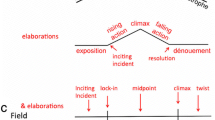Abstract
Creative professionals search for music to accompany moving images in films, advertising, television. Some larger music rights holders (record companies and music publishers) organise their catalogues to allow online searching. These digital libraries are organised by various subjective musical facets as well as by artist and title metadata. The purpose of this paper is to present an analysis of written queries relating to creative music search, contextualised and discussed within the findings of text analyses of a larger research project whose aim is to investigate meaning making in this search process. A facet analysis of a collection of written music queries is discussed in relation to the organisation of the music in a selection of bespoke search engines. Subjective facets, in particular Mood, are found to be highly important in query formation. Unusually, detailed Music Structural aspects are also key. These findings are discussed in relation to disintermediation of this process. It is suggested that there are barriers to this, both in terms of classification and also commercial/legal factors.
Similar content being viewed by others
References
Nanopoulos A., Rafailidis D., Ruxanda M., Manolopoulos Y.: Music search engines: specifications and challenges. Inf. Proc. Manage. 45(3), 392–396 (2009)
Inskip, C., Macfarlane, A., Rafferty, P.: Organizing music for movies. In: Proceedings of International Society for Knowledge Organization (UK) Content Architecture Conference, London, pp. 22–23 (2009)
Bainbridge, D., Cunningham, S., Downie, J.: How people describe their music information needs: a grounded theory analysis of music queries. In: Proceedings of the 4th International Conference on Music Information Retrieval, 26–30 Oct, Baltimore (2003)
Cunningham, S., Bainbridge, D., McKay, D.: Finding new music: a diary study of everyday encounters with novel songs. Proceedings of the 8th International Conference on Music Information Retrieval, 23–27 Sept, Vienna (2007)
Kim, J., Belkin, N.: Categories of music description and search terms and phrases used by non-music experts. In: Proceedings of the 3rd International Conference on Music Information Retrieval, 13-17 Oct, Paris (2002)
Lee, J., Downie, J.S., Jones, M.C.: Preliminary analyses of information features provided by users for identifying music. In: Proceedings of the 8th International Conference on Music Information Retrieval, 23–27 Sept, Vienna (2007)
LaPlante, A.: Users’ relevance Criteria in music retrieval in everyday life: an exploratory study. In: Proceedings of the 11th International Conference on Music Information Retrieval, 10–13 Aug, Utrecht (2010)
Inskip C., Macfarlane A., Rafferty P.: Meaning, communication, music: towards a revised communication model. J. Doc. 64(5), 687–706 (2008)
Inskip, C., Macfarlane, A., Rafferty, P.: Music, movies and meaning: communication in film-makers search for pre-existing music, and the implications for music information retrieval. In: Proceedings of the 9th International Conference on Music Information Retrieval, 14–18 Sept, Philadelphia (2008)
Inskip C., Macfarlane A., Rafferty P.: Creative professional users’ musical relevance criteria. J. Inf. Sci. 36(4), 52–517 (2010)
Ingwersen P., Jarvelin K.: The Turn. Springer, Dordrecht (2005)
Patton M.: Qualitative Evaluation and Research Methods. Sage Publications, Newbury Park (1990)
QSR: NVIVO Product Homepage. <http://www.qsrinternational.com/products_nvivo.aspx> (2009). Accessed 2 Sept (2009)
Hjørland B., Nissen Pedersen K.: A substantive theory of classification for information retrieval. J. Doc. 61(5), 582–597 (2005)
Paltridge B.: Discourse Analysis. Continuum, London (2006)
Rapee, E.: Motion Picture Moods for Pianists and Organists. Arno Press, New York (1924) (1974 reprint)
Alpert J., Alpert M.: Music influences on mood and purchase intentions. Psychol. Mark. 7(2), 109–133 (1990)
Saracevic T.: Relevance: a review of the literature and a framework for thinking on the notion in information science. Part III: behaviour and effects of relevance. J. Am. Soc. Inf. Sci. Technol. 58(13), 2126–2144 (2007)
Abrahamson K.T.: Indexing of Musical Genres: An Epistemological Perspective. Knowl. Organ. 3/4, 144–169 (2003)
Author information
Authors and Affiliations
Corresponding author
Additional information
This paper is a revised version of one originally presented as part of the Workshop for Exploring Musical Information Spaces at ECDL, Corfu, October 1–2 2009.
Rights and permissions
About this article
Cite this article
Inskip, C., Macfarlane, A. & Rafferty, P. Towards the disintermediation of creative music search: analysing queries to determine important facets. Int J Digit Libr 12, 137–147 (2012). https://doi.org/10.1007/s00799-012-0084-1
Published:
Issue Date:
DOI: https://doi.org/10.1007/s00799-012-0084-1




